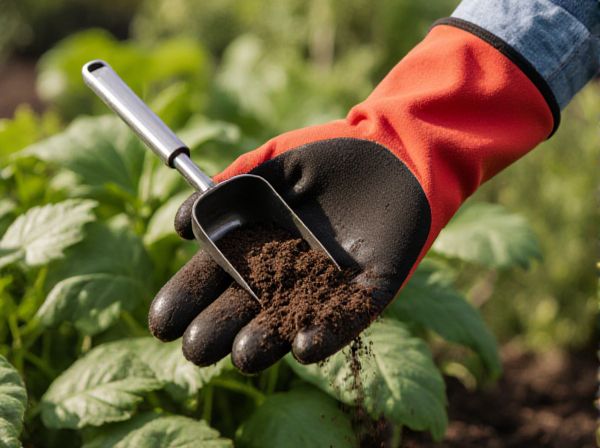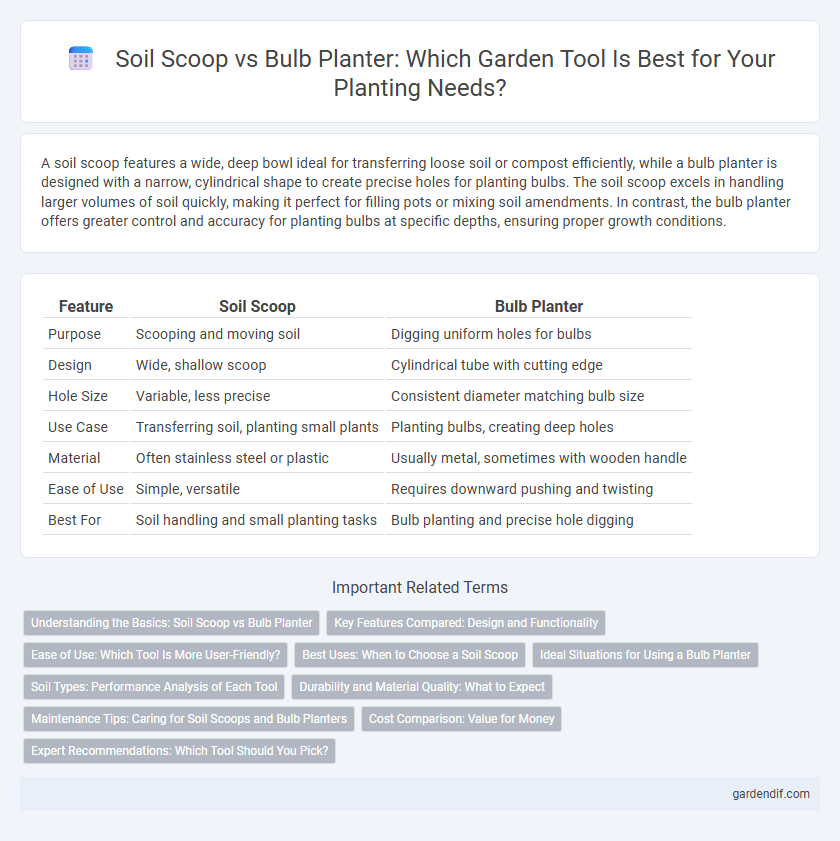
Soil scoop vs bulb planter Illustration
A soil scoop features a wide, deep bowl ideal for transferring loose soil or compost efficiently, while a bulb planter is designed with a narrow, cylindrical shape to create precise holes for planting bulbs. The soil scoop excels in handling larger volumes of soil quickly, making it perfect for filling pots or mixing soil amendments. In contrast, the bulb planter offers greater control and accuracy for planting bulbs at specific depths, ensuring proper growth conditions.
Table of Comparison
| Feature | Soil Scoop | Bulb Planter |
|---|---|---|
| Purpose | Scooping and moving soil | Digging uniform holes for bulbs |
| Design | Wide, shallow scoop | Cylindrical tube with cutting edge |
| Hole Size | Variable, less precise | Consistent diameter matching bulb size |
| Use Case | Transferring soil, planting small plants | Planting bulbs, creating deep holes |
| Material | Often stainless steel or plastic | Usually metal, sometimes with wooden handle |
| Ease of Use | Simple, versatile | Requires downward pushing and twisting |
| Best For | Soil handling and small planting tasks | Bulb planting and precise hole digging |
Understanding the Basics: Soil Scoop vs Bulb Planter
A soil scoop is designed with a deep, rounded shape ideal for transferring loose soil, compost, or mulch efficiently, while a bulb planter features a narrow, cylindrical blade perfect for creating precise, uniform holes for planting bulbs. Understanding the basics involves recognizing that soil scoops excel in soil handling and loading tasks, whereas bulb planters specialize in making consistent planting depths and spacing in garden beds. Selecting the right tool depends on the gardening task, as soil scoops enhance material movement and bulb planters improve planting accuracy.
Key Features Compared: Design and Functionality
Soil scoops feature a wide, deep bucket ideal for moving loose soil or compost, enhancing efficiency in garden bed preparation, while bulb planters have a narrow, cylindrical design tailored for creating uniform holes for bulbs or seedlings. The soil scoop's ergonomic handle provides leverage for scooping and transferring soil, contrasting with the bulb planter's rotating handle often equipped with measurement markings for precise planting depth. Functionality differences highlight the soil scoop's versatility in soil handling versus the bulb planter's specialization in planting accuracy and root protection.
Ease of Use: Which Tool Is More User-Friendly?
The soil scoop offers more ease of use with its wider, deeper design that allows for quick and efficient soil collection, making it ideal for gardeners working with loose soil or compost. In contrast, the bulb planter, with its narrow, cylindrical shape, requires more effort to penetrate compact soil and extract soil plugs, often demanding better technique and strength. For users seeking simplicity and speed, especially in varied soil conditions, the soil scoop presents a more user-friendly option.
Best Uses: When to Choose a Soil Scoop
A soil scoop excels in tasks requiring precise handling of loose materials such as potting soil, compost, or fertilizer for container gardening and seed starting. Choose a soil scoop when you need to transfer soil into small pots or trays without spilling, especially in confined spaces or when working with delicate seedlings. Its deep, rounded shape allows for efficient soil movement, making it ideal for detailed planting and soil amendment tasks.
Ideal Situations for Using a Bulb Planter
A bulb planter is ideal for planting flower bulbs, as it creates uniform, deep holes quickly and efficiently in garden beds with loose or moderately compacted soil. This tool is perfect for repetitive planting tasks in small to medium-sized gardens where precision and depth control are essential for bulb growth. Bulb planters excel in situations where minimal soil disturbance is desired to maintain soil structure and promote healthy root development.
Soil Types: Performance Analysis of Each Tool
Soil scoops perform best in loose, sandy soils due to their wide, shallow design that allows for easy scooping and sampling. Bulb planters excel in dense, clayey soils by efficiently extracting compact soil cores for precise planting holes with minimal disturbance. Understanding soil type compatibility improves planting accuracy and tool efficiency in gardening tasks.
Durability and Material Quality: What to Expect
Soil scoops are typically made from heavy-duty stainless steel or reinforced plastic, offering superior durability for digging and transferring soil in various gardening tasks. Bulb planters often feature robust steel barrels with ergonomic wooden or plastic handles designed to withstand repetitive pressure while maintaining comfort. Expect soil scoops to excel in corrosion resistance and impact strength, while bulb planters prioritize precision and longevity in material quality for planting bulbs efficiently.
Maintenance Tips: Caring for Soil Scoops and Bulb Planters
Regularly clean soil scoops and bulb planters with water and a brush to remove dirt and prevent rust. Sharpen the edges of metal tools periodically to maintain efficiency and reduce effort during use. Store both tools in a dry, sheltered area to protect them from moisture damage and prolong their lifespan.
Cost Comparison: Value for Money
Soil scoops typically offer greater versatility and durability at a lower price point, making them a cost-effective option for gardeners needing a multipurpose tool. Bulb planters, while often more expensive due to specialized design for precise bulb placement, provide value through time savings and consistent hole size for optimal bulb growth. Evaluating cost versus functionality, soil scoops deliver better value for general use, whereas bulb planters justify their higher cost for specialized gardening tasks.
Expert Recommendations: Which Tool Should You Pick?
Experts recommend selecting a soil scoop for versatile tasks such as transplanting seedlings and mixing soil, thanks to its deep, rounded design that efficiently moves loose soil and compost. A bulb planter is ideal for gardeners focused on planting bulbs, offering precise, uniform holes to optimize bulb placement and growth. Consider your primary gardening needs: choose a soil scoop for multi-purpose soil handling or a bulb planter for specialized, efficient bulb planting.
Soil scoop vs bulb planter Infographic

 gardendif.com
gardendif.com